The coleus plant (Coleus) is a very popular herb in ornamental gardens because it can add so much vibrancy to your garden thanks to its colorful foliage.
There are a number of different species of this herb and they come in an annual, perennial, shrub, or succulent form. This beautiful plant has many garden uses because it can grow well in containers as well as in the soil and the plants are handy for ground covers, as filler plants, or for creating striking borders.
This medicinal plant looks its absolute best if it is paired with flowering plants that can add even more color to your garden or when you combine it with other foliage varieties that can compliment coleus or add more texture to your garden.
In this guide, we are going to take a look at some of the best companion plant varieties to grow next to coleus.
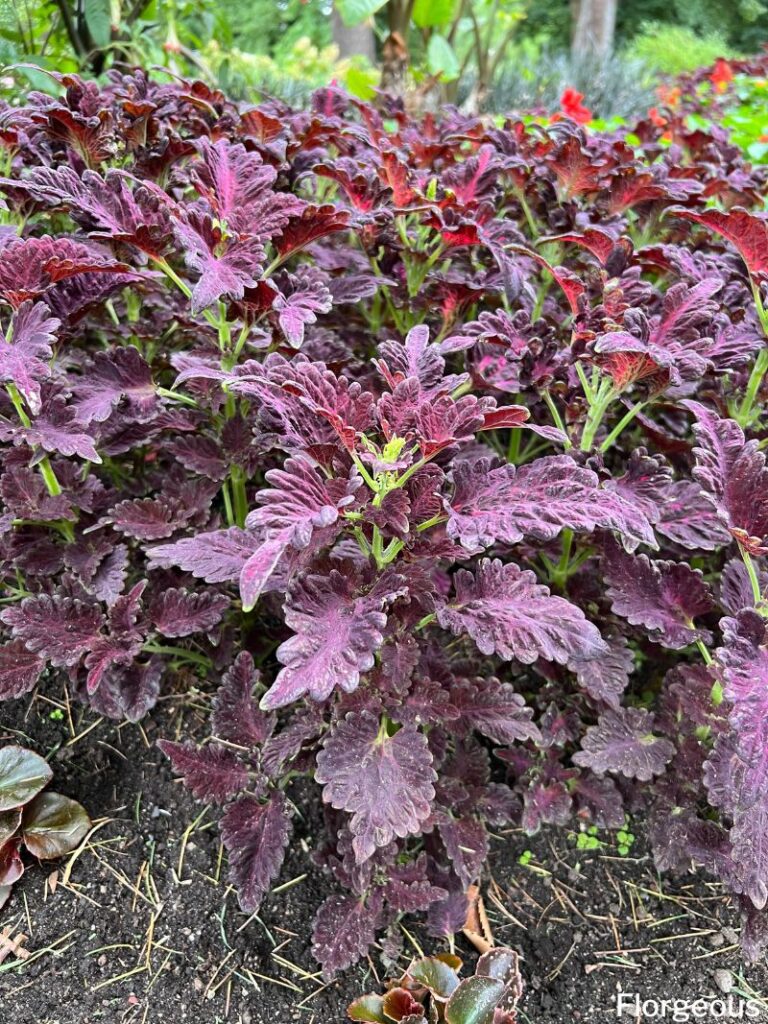
What to Plant with Coleus in a Container or Garden
The coleus plant is ideal for a container garden because they grow well in well-draining but moist soil that is often used in containers. They won’t grow well in heavy clay soils but still require fertile or nutrient-rich soil. As potted plants, you can position them in a sunny or part shade spot in your container garden and they should grow just fine. But you can also establish these striking herbs in garden beds.
Let’s take a look at some of the best companion plants to combine if you want to create striking containers.
Sweet Potato Vine
Sweet potato vine (Ipomoea batatas) will make a great coleus plant combination if you want to create a container that has a thriller, filler, and spiller effect.
The bright coleus plant will serve as a good filler plant while the sweet potato vine will act as a spiller that can trail out over the edge of the pot for a dramatic waterfall effect.
Yellow-tinted sweet potato vine will look especially striking if you pair it with a vibrant shrub variety like kong jr coleus.
Sweet potatoes are very easy to grow in containers but many gardeners recommend clay, wooden or concrete containers and claim it is best to avoid plastic or metal containers since these can affect the growth of the vine plant.
Your sweet potatoes will grow vigorously in well-draining sandy soil with lots of compost. They can be positioned in full sun but should be kept moist but not too wet.
For optimal effect, it is best to have the vine plant stream out from underneath the bushy coleus shrub but be careful to select a large enough container because coleus shrubs can grow rather vigorously.
Begonias
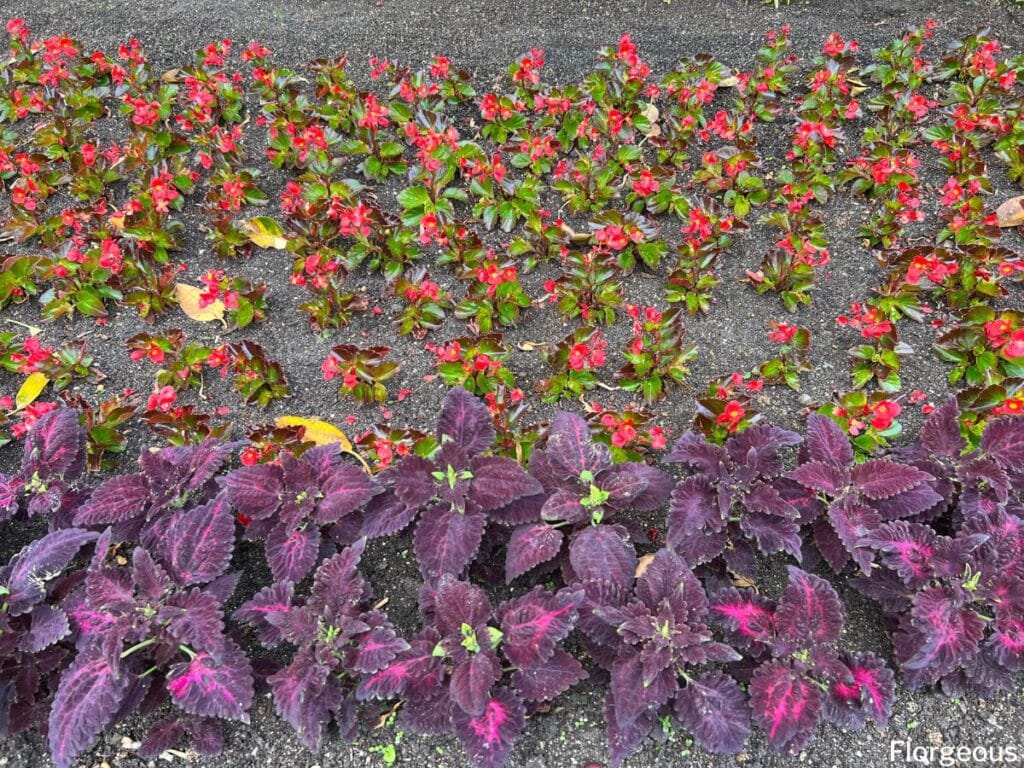
Begonias (Begonia) are a welcome addition to any shade garden and they are perfect coleus companion plants because they will add lots of color and charm to your garden when they start producing vivid flowers.
There are thousands of different cultivars of begonias and you can get them in just about any color under the sun. The flowers can range from simple blooms to striking rose-like florals.
Begonias will look terrific next to coleus plants and can be grown in the ground but they are also great container plants. These plants thrive in well-drained soil that is kept moist and it prefers indirect sunlight or semi-shade.
Most begonia varieties are a little bit shorter compared to coleus plants. As such, it is usually better to position these succulents in the front of your garden bed or as a border around the taller coleus plants.
Purple Fountain Grass
When you grow a container garden with coleus as a filler plant and a vine plant as a spiller, you will also need to add a thriller plant to add some vertical interest to your little garden.
A tall variety of ornamental grass like purple fountain grass (Pennisetum setaceum rubrum) is perfect for these types of container designs.
These ornamental grasses will add plenty of interest when they produce long slender burgundy colored leaves with delicate feathery flowers.
Purple fountain grass can grow well in containers as long as they are positioned in a sunny location in well-draining soil. They will tolerate some light shade and need to be kept moist.
When you are pairing coleus with fountain grass, you should be careful to select coleus varieties that are shorter than 3 feet tall so your fountain grass can stand out nice and tall.
It is also important to choose large enough containers so the coleus and grass can both have plenty of room to expand and grow.
Salvia
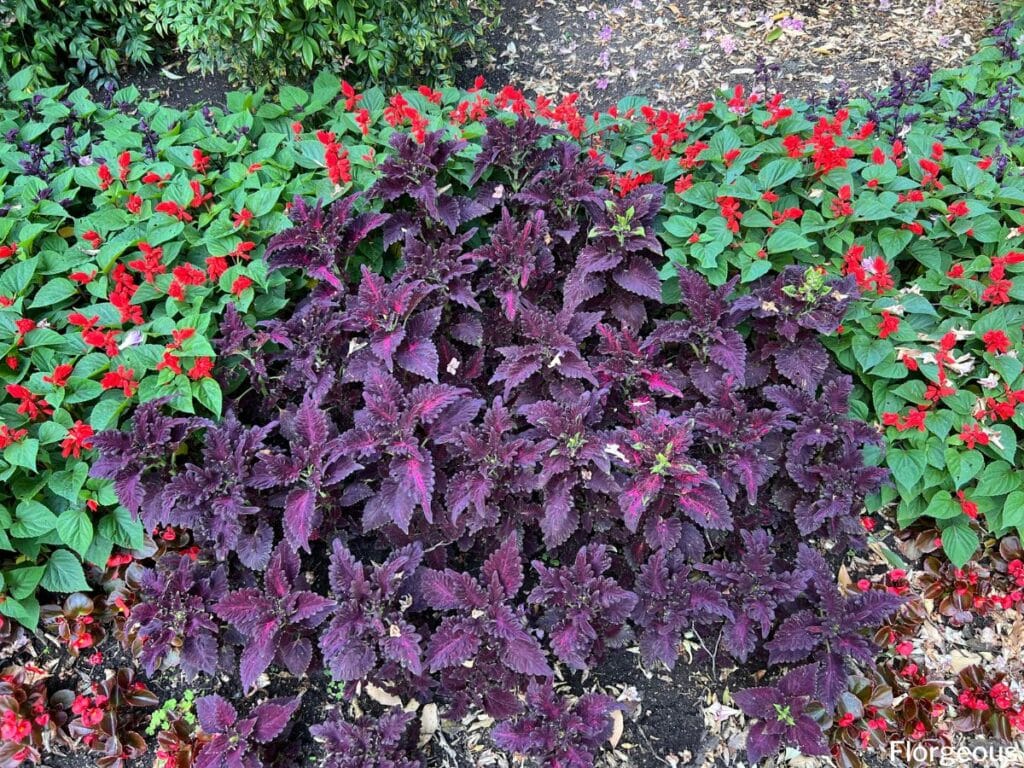
Salvia flowers (Salvia officinalis), also known as sage, are also a member of the mint family and can be great companion plants for coleus if you are looking for something tall that can shelter your coleus plants from the sun.
When you are doing companion planting with sage and coleus, you do need to be a little bit cautious about watering these plant combinations in the same pot. Coleus requires regular watering while sage is more drought tolerant and can develop root rot if it is over-watered.
Sage will grow very well in any type of well-draining soil and it flourishes in direct sun. The herb can also grow well in part shade but might not produce as many flowers.
When you are pairing these plants, you should establish coleus in the front and the taller sage in the back.
The sage will create some shade that can protect your coleus and together, they will create a rather striking look, especially if you pair sage with a coleus variety that will complement the vivid purple tones of the purple flower spikes.
Fuchsia
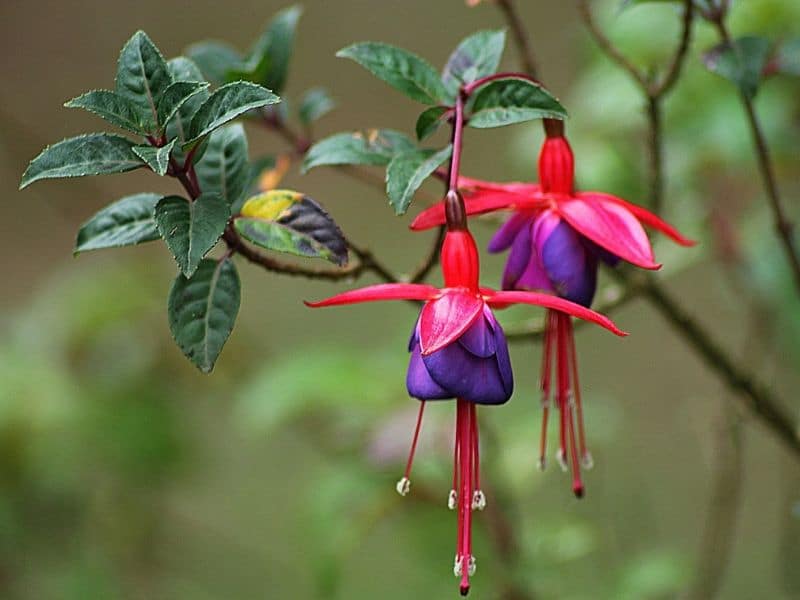
Fuchsia flowers (Fuchsia) are shrubs or small flowering trees that can add lots of vibrant colors to your garden. These plants will produce masses of dramatic pink and purple bell-shaped flowers from summer to late fall.
Fuschia can grow well in gardens and containers. They can grow very well in full sun or partial shade but don’t tolerate cold winds too well. In particularly hot areas it is best to position them in shade during the warmest time of the day. These flowers also need to be planted in well-draining but fertile soil that is kept moist.
The vivid flower colors will accompany any variety of coleus very well but we especially recommend the Chartreuse coleus variety because the golden yellow leaves will look rather striking next to the pink and purple tones of these flowers.
These flowering plants can grow rather tall with a height of up to six feet which means you should establish them behind your shorter coleus plants.
Dwarf varieties of fuchsia can be grown amongst the coleus plants in your garden bed because they have a similar height to the colorful shrubs.
Impatiens
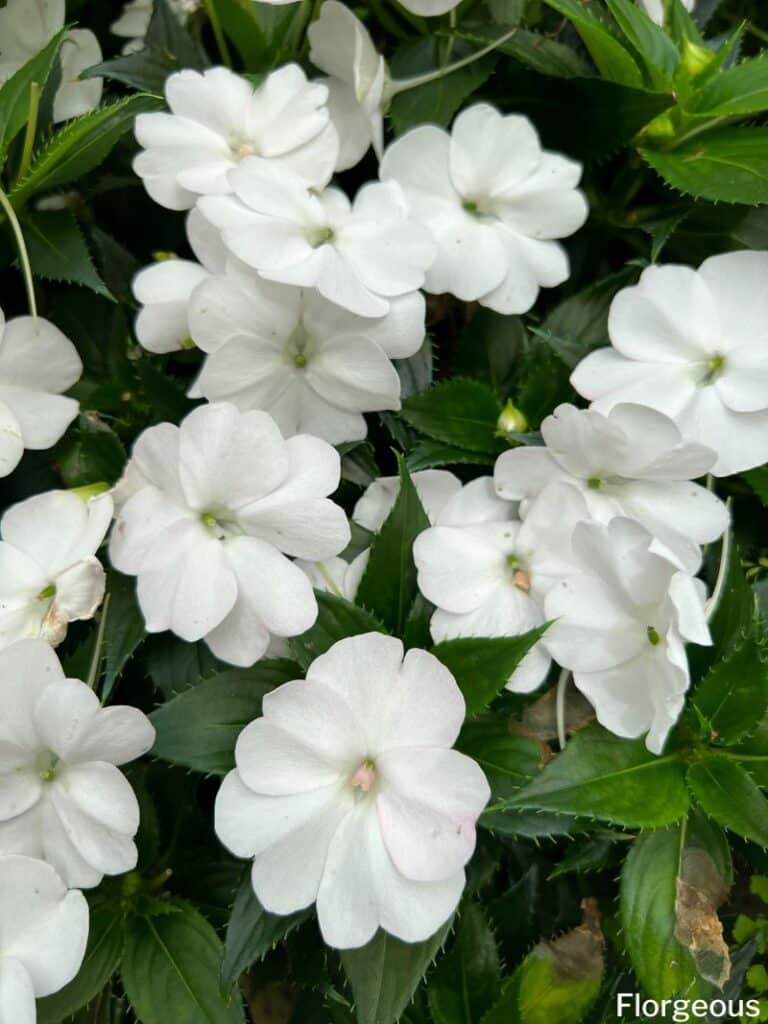
If you are looking for container planting ideas, coleus and impatiens can be an excellent combination.
The colorful foliage of coleus will definitely enhance the white, pink, red and orange impatiens flowers and create a stunning tropical pot display.
Similarly, when selecting impatiens companion plants, they need to have contrasting colors to create a visually appealing garden.
Lantana
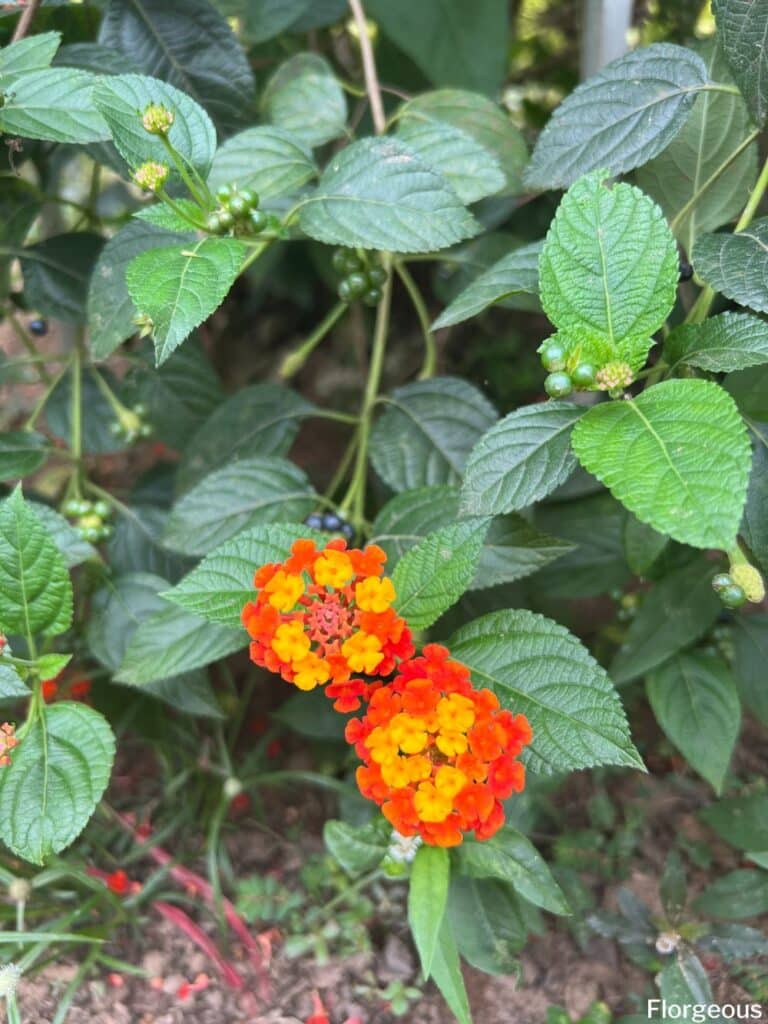
You can add lantana to your coleus mixed planters to decorate your patio garden.
With over 150 species, Lantana is a large flowering shrub native to Central and South America.
Lantana prefers moist soil but can withstand prolonged periods of drought. It tolerates a wide range of soil types but thrives in well-drained, fertile soils, including rich organic well-drained soils.
Caladium
Coleus and caladium will add color, texture and structure to your garden with their vibrant foliage.
Caladiums require two to four hours of direct sun to produce lush growth with large and colorful leaves, so plant them in shade to part shade with bright dappled light.
Caladiums grow beautifully in containers, raised beds and patio pots and in well-drained soil in landscapes.
What NOT to plant with Coleus
Not all plant varieties will grow well in a shade garden and planting coleus in a dry and sunny spot will undoubtedly cause a lot of growth and development issues. If you want your coleus to grow well then you should avoid the following plant combinations.
Drought Tolerant Plants
Coleus plants can survive short spells of dryness but the leaves can quickly become droopy if the soil dries out completely. If this happens, you will need to water your plant as soon as possible.
Because of coleus’s high watering needs, drought-tolerant plants usually are not good companions. Drought-tolerant plants are likely to develop root rot if they are planted in soil that is kept moist all the time.
It is best to avoid drought or hardy plants like chives, smoke bushes, cactuses, lavender, coneflowers, sedum, and other varieties that prefer full sun and dry soil.
Deep Shade Plants
Coleus plants are common in shade garden areas because they grow well in dappled shade. But if the plants are established in full shade, their leaves will lose their vibrant color.
Flowers that don’t grow well with coleus are deep shade loving flowers. If you want to maintain the colorful foliage then you should avoid planting them next to deep-shade plants like dark green hostas.
Final Thoughts
Coleus is a great shade-loving plant to grow if you want to add more color to your garden. There are many different color varieties to choose from and their leaves can have different shapes that can add lots of texture to your garden.
These shade-loving plants will also grow well next to a huge variety of companions like sage, ornamental grass, begonias, fuchsia, and sweet potato plants.
We hope that this guide helped you find some great plants to grow next to or in the same container as coleus.
If you are busy establishing other plant varieties in your garden then you should have a look at some of our other companion plants for landscaping guides where you can learn even more about companion planting and the best plants to pair in gardens.







